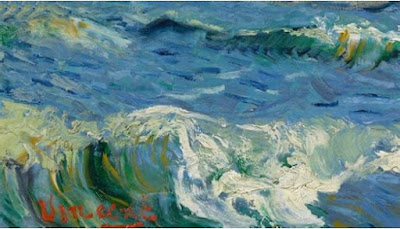*Reflections after Visiting the Van Gogh Museum in Amsterdam, the Netherlands (June 2022)
Vincent Van Gogh goes down in art history as a man who viewed things differently, imagining color where no hue was. As he studied painting, Van Gogh increasingly created art pieces vibrantly displaying emotion.
Writers such as William Wordsworth and Walt Whitman found inspiration in the common man. Similarly, Van Gogh became enamored of peasants. His early works show Van Gogh to be more realistic, fascinated by everyday people and events. In his Potato Eaters, work-worn hands reach for home-baked bread. Earth-stained faces, having toiled in soil, brighten at mealtime. This painting took years of master planning to complete. To properly view these features, one must stand before the painting, allowing his eyes to adjust to its low light before perceiving the details Van Gogh hid.
The Potato Eaters
Later Van Gogh works reflect lighter colors and illustrate his fascination with other genres and places. Following a stint in Paris, Van Gogh became enamored of Japanese art. This style makes its way into some of his later works. In the Almond Blossom, he depicts blue stripes on the lowest branches so that viewers’ eyes might travel upward, into the budding blossom, set in front a canvas of turquoise.
The Almond Blossom
He displayed color-driven creativity, particularly in his art pieces based on black and white prints by an artist named Millet. Observing Millet’s works, Van Gogh repainted them, adding color where none was—in his words, “like a musician interpreting a composer’s work.”
Van Gogh sought to portray the inner truth of his subjects, looking beyond the readily observable to worlds of truth hidden under the surface of mankind or the world.
 |
| In the Café: Agostina Sagatori in Le Tambourin |
To him, the inner man; the moment’s emotion; the soul behind the face—these he deemed more significant than actual realism. Resultantly, his colors portray feeling, making tangible the emotional aura of a subject more than that individual’s actual appearance.
In his painting In the Café: Agostina Sagatori in Le Tambourin (pictured left), he uses yellow on stationary chairs to make viewers’ eyes move around the painting. The orange tambourine tabletop and Agostina’s fine red hat strikingly contrast to the muted tones of the rest of the painting.
In one dominantly azure sea scape (pictured below), he chose to imprint his name in scarlet, providing a complete contrast to the rest of the piece.
Van Gogh observed from life when he painted. And yet, what he depicted seems much different from real life portrayals, such as he sought to paint in earlier works. As he grew and developed as a painter, Van Gogh chose to paint how he perceived things, instead of reflecting them exactly as they were.
Van Gogh's perspective offers insight for the born-again believer.
Affections on things above.
Heavenly citizenship.
These phrases describe the kinds of ideals that are to shape the Christian’s faith-filled vision.
In a practical sense, how do believers daily develop this eternal perspective? How do we choose to view the world so that our perception is marked by the forever? How do we place our gaze beyond what we view each day to things that are everlasting, framing our perspective on eternity and the eternal souls of humankind?
These phrases describe the kinds of ideals that are to shape the Christian’s faith-filled vision.
In a practical sense, how do believers daily develop this eternal perspective? How do we choose to view the world so that our perception is marked by the forever? How do we place our gaze beyond what we view each day to things that are everlasting, framing our perspective on eternity and the eternal souls of humankind?
One way to acquire such a perspective is from Scriptural meditation: The psalmist wrote, “The entrance of Thy words giveth light; it giveth understanding unto the simple” (Psalm 119:130). Letting God’s Word shape our thoughts and ideals serves as a crucial means in helping us develop an eternal vantage point, from which all of life is colored to reflect the light of God’s truth.
Photo Credits
The Potato Eaters: https://www.vangoghmuseum.nl/en/visit/whats-on/the-permanent-collection-van-goghs-masterpieces
The Almond Blossom: https://www.vangoghmuseum.nl/en/collection/s0176V1962
In the Café: Agostina Sagatori in Le Tambourin
https://en.wahooart.com/a55a04/w.nsf/Opra/BRUE-5ZKG4W
Seascape Saintes Maries-de-la-Mer: https://www.fineartphotographyvideoart.com/2020/06/Vincent-van-Gogh-Seascape-Saintes-Maries-de-la-Me.html



Comments